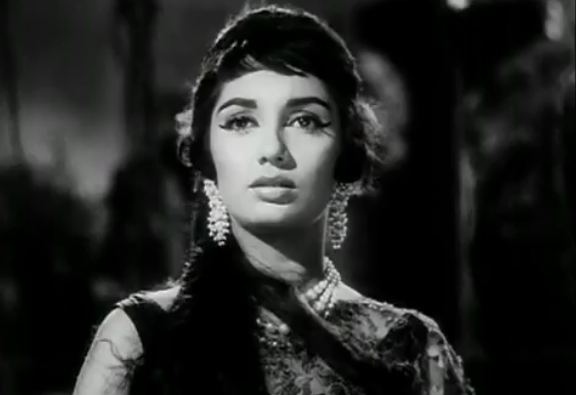A dark stormy night… Dr Anand (Manoj Kumar) comes across a mysterious woman (Sadhana) who takes him to a graveyard and vanishes. Soon, his life turns upside down. His fiancé, Seema (Helen), is killed, he reluctantly agrees to an arranged marriage and the bride, Sandhya (Sadhana again), turns out to be the spitting image of the ‘ghost’ he saw! As Anand struggles to make sense of the crazy happenings around him, the climax reveals a convoluted plot concocted to cheat Kumar out of his substantial inheritance!
Raj Khosla was perhaps the most underrated filmmaker in Hindi Cinema. Having come to Bombay to be a singer, he became an assistant to Guru Dutt from Baazi (1951) to Aar Paar (1954) before making his first film, Milap (1955). Khosla’s strength was that he could easily shift from genre to genre while adding his own personal stamp to each of his films be it the thriller (CID (1956)), the intense love story (Do Badan (1966)), the family social (Do Raaste (1969)) or the dacoit drama (Mera Gaon Mera Desh (1971)). Thus, his filmography has a versatility and a range seen in very few Indian filmmakers.
Woh Kaun Thi? (1964) is the first and perhaps best of Khosla’s mystery-trilogy films with 60s icon Sadhana – the others being Mera Saaya (1966) and Anita (1967). The film is loosely adapted from Wilkie Collins’ The Woman in White, which even mentor Guru Dutt had tried to film earlier but, ultimately dissatisfied with the production, he had abandoned it. The ill-fated project, titled Raaz, starred Guru Dutt himself with Waheeda Rehman and Kum Kum and was to be directed by Dutt’s assistant, Niranjan, and was also to be music director RD Burman’s debut making film. Once Dutt abandoned Raaz, Khosla borrowed the script from his ‘teacher’ and reworked it to the film we know today.
Woh Kaun Thi?, though admittedly dated (today Sadhana’s Mujhe Khoon Pasand Hai dialogue comes across as plain corny), sees Khosla satisfyingly create a mysteriously adequate ambience from fog-filled nights to creaky doors to abandoned old ruins right from its opening on the cursory dark stormy night. He handles the suspense elements well enough to keep the film and its plot moving along with enough red herrings thrown in to keep the viewer hooked on to the events unfolding on screen. Of course, logic is sacrificed for effect at places but keeps you engaged enough to go along with the narrative. Where the films fails, however, is the final denouement, which, when it comes, is pretty weak and a bit of an anti-climax after all the big build up.
The film showcases Sadhana at her ‘mysterious’ best as she goes through a range of enigmatic smiles to confuse the hero, a surprisingly restrained and consequently wooden and eternally confused-looking Manoj Kumar. Sadhana’s biggest tragedy was that she was always looked upon as a fashion icon and filmmakers too exploited her for only for glamorous roles when, in fact, she was quite the capable actress. She does leave an extremely strong mark in Woh Kaun Thi?, both, with her looks as well as her performance as the good and evil twin sisters. In fact, the film is the first of ‘double roles’ for Sadhana, who would also play dual characters in Mera Saaya, Geeta Mera Naam (1974) and Mahfil (1981). It is to her credit that she makes the roles in Woh Kaun Thi? her own, especially as initially, the project was conceived not with her but with Nimmi in mind. Today, Woh Kaun Thi? and Sadhana are synonymous with each other and the film is unthinkable without her. Among the other actors, Helen is rather good as Manoj Kumar’s former girlfriend, who is murdered, and Parveen Chowdhary is fine as Kumar’s colleague, who also loves him. Prem Chopra makes an adequate villain.
On the technical side, special mention must be made of the extremely effective moody black and white cinematography by KH Kapadia, Kapil Divecha’s eerie audiography and Madan Mohan’s melodious music, easily one of his career’s most memorable scores. Naina Barse Rhim Jhim Rhim Jhim, Lag Ja Gale, Jo Humne Dastan Apni Sunaayi and Shokh Nazar ki Bijliyan among others are brilliantly composed and aided by Khosla’s incredible song picturizing abilites – in particular, the poetic filming of Lag Ja Gale rendered perfectly by Lata Mangeshkar – the film is lifted by several notches.
Woh Kaun Thi? is easily one of the better crime thrillers seen on the Indian screen. The film was remade in Tamil (Yaar Nee (1966)) and Telugu (Aame Eravu (1966)), with J Jayalalithaa taking on the role(s) in both versions. Composer Vedha, who scored the music for both films, reused the tunes in both Tamil and Telugu from the Hindi original. Khosla himself revisited the film as Naqab (1989) with Rishi Kapoor and Farha but this time, the film flopped at the box-office.
Woh Kaun Thi? was nominated at the Filmfare Awards for Best Actress, Best Music and Best Cinematography, Black and White. KH Kapadia won the award for his fine camerawork while Sadhana and Madan Mohan lost to Vyjayanthimala (Sangam (1964)) and Laxmikant-Pyarelal (Dosti (1964)), respectively.
Hindi, Thriller, Black & White


